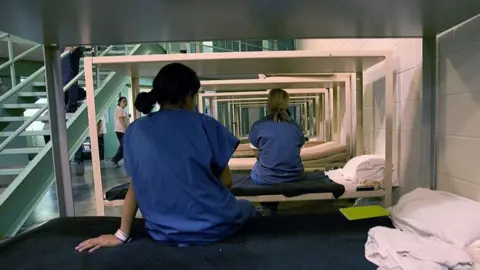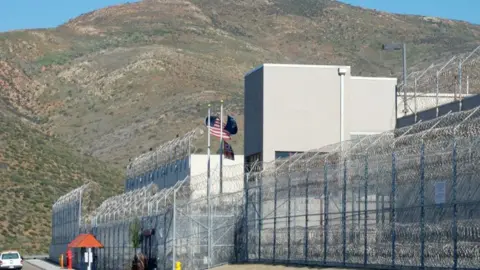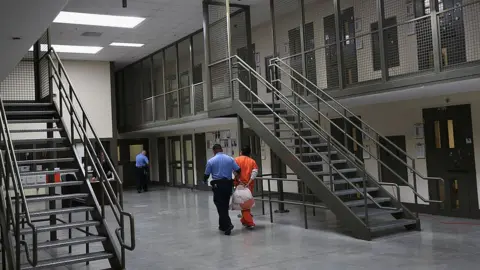Coronavirus: Immigration detention centres in crisis
 Getty Images
Getty ImagesAs coronavirus continues to spread, a crisis is growing inside ICE immigration detention centres in the US.
Verónica says that for days she has only been fed bread and water because the cooks stopped working due to the coronavirus pandemic. She is a young Salvadoran asylum seeker who has been detained in an immigration centre in the US since October of last year.
At the centre she is held at in Otay Mesa, in San Diego, California, they were not given any face masks or gloves as protection, despite the fact that there were already confirmed positive cases of Covid-19 inside the facility, says the 23-year-old.
"There is no medical assistance here, they don't take care of us, they tell us to gargle with salt water, that we are fine, that it is just a cold," she says in a phone call on 21 April.
So Verónica decided with another colleague to put together pieces of T-shirt fabric and, with daily sanitary pads and hair ties, make protective masks. Her description is replicated by more immigrants who spoke to the BBC not only in Otay Mesa but other centres, and by organisations that provide legal advice and that are constantly communicating with detainees.
As of Thursday, the US Immigration and Customs Enforcement Service (ICE) confirmed 490 confirmed cases of Covid-19 in an estimated population of 31,000 detainees. Only 1,030 detainees have been tested up until the same date.
There have been no deaths as a result of Covid-19, according to information that ICE sent to the BBC.
Despite the fact that ICE assures on its website that the health, safety and well-being of detainees are "among the highest priorities", in recent weeks groups of immigrants have started hunger strikes in protest and several courts have ordered the release of detainees.
What is happening?
Verónica says that she sleeps in a cell "with eight beds, one on top of the other at a distance of about a metre" and that she lives with four other women. "We use the same bathroom... we are not in an environment where you can have social distancing" she says.
The detention centres are managed by private companies and have different sizes and layouts, but the detainees and organizations BBC spoke to agree that there are often spaces where hundreds of people live together and that cells are shared.
 Getty Images
Getty ImagesIn addition, detainees are in charge of cleaning the areas they use, including collective toilets, and do so without protection such as gloves or face masks.
"(Detainees) only have access to one bar of soap for the entire week," says Veronica Salama, an immigration attorney at the US human rights organization Southern Poverty Law Center (SPLC).
Ms Salama warns that her clients "had no idea of the severity of this disease" at first and that "officials did not inform them of anything or gave them any handouts with instructions for hand washing".
"There are officials who enter the units where the detainees are to deliver food without gloves or masks," she says.
The situation has led to "people organising themselves in 30 facilities to demand changes and in 13 of them there has been retaliation", says Cynthia Galaz, from the organisation Freedom For Immigrants, which has a direct telephone line to connect with detention centres.
Ms Galaz has gathered testimonies from people who say they have received threats that they would be sprayed with pepper spray or transferred to a solitary confinement area, informally called "el hoyo" (the hole).
"They throw people into a room where they are alone for a long time and basically people describe it as psychological torture," she points out.
In addition to lawsuits filed in courts calling for the release of specific detainees, a federal judge ordered ICE last week to identify and consider releasing those immigrants in their custody whose age or health condition puts them at risk of getting sick with Covid-19.
Judge Jesús Bernal, from a federal court in Los Angeles, determined that the evidence presented "suggests a systematic inaction" by the government "that goes beyond a mere 'difference of medical opinion or negligence'".
What does ICE say?
The ICE press office referred BBC to a website with information on its response to the pandemic in detention centres.
The agency indicates there that nearly 700 people have been released "after evaluating their immigration history, police record, and whether they pose a possible threat to public safety, or are at risk of flight, or represent a national security concern". Additionally, they say, they have limited the entry of new detainees.
"ICE's detained population has dropped by more than 4,000 individuals" since 1 March, they said. In addition to temporarily suspending all visits, the agency "decided to reduce the population of all facilities to 70% or less to increase social distancing".
Detainees with symptoms of fever or respiratory problems are "isolated and monitored" for a specified period of time.


- A SIMPLE GUIDE: What are the symptoms?
- LEADING THE WAY: How California kept ahead of the curve
- ON FRONTLINE: The young doctors being asked to play god
- FACTORY HOTSPOT: The untold story behind America's biggest outbreak
- REASON TO HOPE: The good that may come out of this crisis

Those who do not have the symptoms mentioned above, but "who are included in the epidemiological risk guidelines" are monitored for 14 days. Those with moderate to severe symptoms or those requiring "higher levels of care or monitoring" are transferred to hospitals.
The agency, however, did not provide information to the BBC on how many people have been hospitalised.
'They never tested me'
Rosmary Freites is one of the immigrants who, due to her medical condition - she is diabetic and asthmatic - was released from the Broward Transitional Center (BTC) in Florida, after the organisation United We Dream helped her by filing a petition with more than 1,000 signatures for her release before a judge.
Ms Freites, a 23-year-old from Venezuela, describes how she was isolated in a room with five other detainees for a couple of days and that when she asked why, officials told her that a person who was there had contact with a lawyer who tested positive for Covid -19.
"After two days they took us out of the quarantine and they never tested me or gave me a mask," she says. The SPLC documented that the Krome detention centre in Miami had four spaces set aside for people in quarantine and that "people are going in and out, it is not really a quarantine".
Another reported problem is the transfer of immigrants from one centre to another, which is what happened to Anette Villa's husband, who is asthmatic.
 EPA
EPAThe Cuban woman says that in recent weeks her husband went through at least three different centres before finally being admitted to Baker, in north-central Florida.
"The pandemic was already under way and with all the transfers they made him do while they were processing him, he spent two nights sleeping on the floor" she describes.
Ms Villa, who lives in Florida, says that her husband travelled from Mexico and that he claimed asylum before the border authorities 11 months ago. "He knows that if he catches the virus, his lungs are going to collapse. He is panicking and I tell him to calm down. I am afraid he will die," she says.
'They sprayed us with pepper spray'
Otay Mesa Detention Center, where Verónica is held, currently has the most confirmed cases of Covid-19, with 98 detainees and 8 ICE employees infected. Organisations like the SPLC fear that the number is higher.
"We don't know all the details of what is happening inside, the situation is not transparent," says lawyer Maia Fleischman, referring to all the centres.
Otay Mesa made headlines in recent days after audios were released in which a detainee describes the moment when a group of detainees were allegedly pepper sprayed inside their cells.
The incident was reported on 10 April, after a group of detainees refused to sign a document, in which they say the company that manages the detention centre was released from responsibility in the events that anyone caught the virus. Only after they signed the documents would they would be given masks, they say.
"The attack happened in my unit," says Briseida Salazar, a 23-year-old Mexican woman who was released on bail days later. Ms Salazar, one of the few who spoke English in the group of more than 60 women, helped translate the document for the others and, as a result, they refused to sign it.
"At one point we got very frustrated and started to protest and the manager who was there told us that we were making a lot of noise and called the emergency team and they came up with the pepper spray."
 Getty Images
Getty ImagesVeronica, who was on the phone at the time with a member of the organisation Pueblos Sin Fronteras (PSF), shouted that they were being pepper sprayed and that they were handcuffing a detainee suffering from mental health issues. ICE confirmed the facts, but denied that pepper spray had been used.
"Contrary to numerous reports, there was no use of force or chemical agents dispersed during the incident", adding that the allegations were "simply not true".
According to PSF, which exchanges daily calls with detainees in Otay Mesa, there are more than 100 detainees on hunger strike protesting about the lack of testing and protective measures.
In another part of the facilities, detainee Samuel Gallardo Andara, a 28-year-old Venezuelan nurse, says that in the area where he is being held, of about 100 people, "half of them have become ill".
"Doctors have monitored us and given us Tylenol, that's it."
Immigrants' rights organisations have filed lawsuits against ICE detention centres in the past denouncing irregularities with medical assistance inside the facilities. The pandemic has highlighted problems that have existed inside these facilities for a long time, these organisations say.
From the phone, Veronica says that she is very stressed and that at the moment she does not see a "way out of this".
"What we are living here is very difficult, very difficult," she says right before the time allowed for her call runs out and the line is down.
